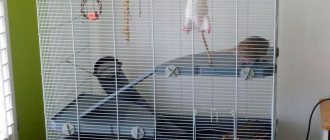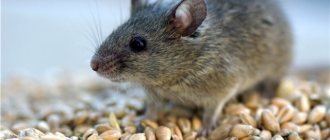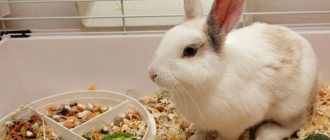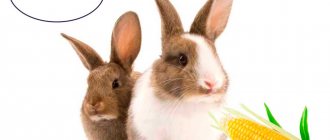February 16, 2019 Vladimir Khomyakov
Nothing will be lost
This article will be useful for rabbit breeders, as it provides another key to saving money on farms without much investment. It is proposed to fence off part of the rabbitry for keeping chickens. If you have chosen the outdoor shed method of raising rabbits, you will need to build a small chicken coop and provide the chickens with access to graze under the cages. Looking ahead, I will reveal the secret of the announced benefits. This is a saving on feed, due to the peculiarity of chickens to dig under the cages and finish up spilled feed after the rabbits. Even two or three good laying hens will delight you with a stable additional income in the form of homemade dietary eggs.
At one time I practiced such joint breeding and was pleasantly surprised by the effect obtained. Even without any special theoretical preparation, everything turned out well. True, then he changed direction and instead of birds settled goats in the vacated area. Circumstances were such that the need for healing milk, including for feeding mother rabbits and young rabbits, made appropriate adjustments. But that, as they say, is a completely different story. And recently, our regular participant, Andrey Kudakov from Troitsk, Chelyabinsk region, shared his positive experience on our forum. Therefore, I decided to touch more deeply on this topic, supplement my own observations and present the material in the form of a separate article.
Keeping chickens and rabbits together
In cases where it is not possible to keep rabbits and chickens separately, you should ensure the most comfortable conditions for each “neighbor”:
- allocate and fence off a separate area for eating. Rabbits should not have access to the bird feeder, and vice versa;
- take care of acceptable temperature conditions: eliminate the possibility of drafts, avoid overheating and excessive cooling of the enclosure;
- allocate an individual place for sleeping: rabbits must have their own closed corner for rest, and the bird must be sent to a special closed enclosure to roost at night;
- exclude the cohabitation of two male rabbits together: in this case, not only the chickens, but also the furry animals themselves will suffer and be bitten;
- There should be no more than a dozen chickens for every 2 rabbits - otherwise the rabbits will become irritable, lose sleep and appetite, and show aggression.
Video: keeping chickens and rabbits together
In any case, the cohabitation of rabbits and chickens will cause inconvenience: such a neighborhood will irritate the animals, frighten them and disrupt their natural behavior. It is best to keep these pets separately, and only in cases of extreme necessity, taking into account all the nuances and subtleties of keeping, can you combine the pastime of these animals.
Try to create maximum comfort for the animals, taking into account all the recommendations given, you can provide your pet rabbits and birds with a completely tolerable coexistence
If everyone is vaccinated, is it possible to keep chickens and rabbits in the same room?
You can’t keep chickens in the same barn with anyone! The chickens will pass fleas to the rabbits, and the rabbits will go bald.
Yes Yes. It's true about fleas.
What a horror, but at least the cows won’t go bald from the chickens? Do you mean fleas? Don’t fleas and louse live on skinny animals? How can you rid chickens of this nasty thing? I have brooms with wormwood hanging in my barnyard, the air is fresher and it seems to me that all these lice and fleas don’t really like this grass. And I understood everything about rabbits and chickens, thanks for the answer. The only thing that is not clear is that if chickens cannot be kept in the same room with anyone, then they will freeze alone. At least heat comes from the cattle, but the chickens themselves will not heat their coop with heat. Or am I not right?
It is possible to keep chickens and rabbits in the same room; they do not have common diseases. I have been keeping chickens and rabbits in the same room for many years; the chickens roam freely, even in the rabbits’ pen, and even lay eggs there.
Complete nonsense, of course you can! Experience over many years has shown that even in winter it is necessary, they generate more heat for each other and do not interfere with each other at all.
Chickens - rabbits - coccidiosis.
But not everything is so smooth when rabbits and chickens live together. There is one very unpleasant thing called coccidiosis. For those who have forgotten what it is, let me briefly remind you. This is a disease caused by coccidia, single-celled parasites. They settle in colonies mainly in the liver of rabbits, less often in the intestines and form colonies (asexual reproduction) in the form of white inclusions the size of a millet grain or larger. With coccidiosis, rabbits swell, swear, stop growing, and often die when the form is advanced. Chickens can also become infected with coccidia. The greatest risk of death of chickens (up to six months) is from this scourge. Intestinal coccidiosis causes internal bleeding. Then traces of blood are clearly visible in the droppings. Adult chickens get sick less often, but once infected, they stop laying eggs or lay eggs outside the nests. They, however, like rabbits, always look disheveled.
There is an opinion among experts that different types of coccidia (there are more than 10 of them) parasitize a specific type of animal. I'm inclined to the same opinion. For example, people become infected with coccidiosis extremely rarely, only if they have problems with the immune system. But I never found a definite answer. They write that coccidiosis has not been sufficiently studied. Instead of experimenting, I use coccidiostatics. In any case, the load on the body increases when sexually mature oocysts enter it.
WHEN rabbits and chickens are kept together, the risk of infection with coccidiosis increases significantly. To prevent disease, be sure to use coccidiostats in the form of small additives to feed or in the form of scheduled spring and autumn feedings. Cleaning of cells and territory must be carried out at least once a week, before the oocysts have time to turn into sexually mature parasites. It is optimal to clean the cages daily and do general cleaning once a week.
Velcro is an effective remedy.
Why is a chicken-rabbit pairing so dangerous? It's all about the developmental characteristics of the parasite. The male and female cells fused together form an oocyst, which comes out with feces and then matures for a week to the invasive (infectious) stage. If the droppings are not removed within this period, then with the help of flies the developed oocysts end up on the feed and then into the womb of the rabbit. The cycle is completed. And flies are not necessary at all to infect chickens. They walk around and peck at everything themselves. If they come across a grain with a developed parasite, they will swallow it too. Then they themselves become carriers of coccidiosis.
In addition to preventing coccidiosis, Andrey also fights its carriers, flies. In certain periods there are especially many of them flying and then he uses the drug “Deltsid”. I, in turn, as an addition, can recommend adhesive tapes. They are very effective, at the same time they stick a lot of mosquitoes along with midges. And this means minimizing losses from myxomatosis, scratching, and itchy rashes. The result of the entire complex of work is the absence of coccidiosis in both rabbits and chickens throughout the entire time they were kept together in the same barn.
How much land do you need?
The second important question concerns the area allocated for such joint farming. It may seem that you will need to build something large and spacious. Not at all. Andrey fit everything in a solid slag-lit (cinder block) room with an area of 3?4 m and a height of 1.9 m. It seems quite small. I couldn't help but wonder about the availability of ventilation.
After all, it is very important to adhere to sanitary standards so that both rabbits and chickens breathe clean air. Lack of oxygen can have a very detrimental effect on the growth, general condition of animals and even the taste of meat. In my case, for example, there was clearly more space
But practice has shown that air flow through a small window is sufficient.
In my case, for example, there was clearly more space. But practice has shown that air flow through a small window is sufficient.
True, in the summer it’s a little stuffy in the barn. Therefore, you have to keep the door to the street open when it gets warm and until it freezes. In winter, the window is closed almost completely; if it gets warmer, it is opened slightly.
AND STILL, I advise you to build passive supply and exhaust natural ventilation in any household, even a small one. An ordinary pipe (preferably with a turbo deflector), extending outward above the top point of the roof by a meter to one and a half. Otherwise there will be no traction and even a reverse cast is possible
It is important to position the pipe so that the main air flow passes away from cages and perches.
"Dorm": part one
When maintaining a backyard nursery, the question often arises: “Is it advisable to keep animals of different species together?” In particular, is it possible to organize accommodation for feathered and furry pets in an undivided pen or enclosure?
Opinions differ here, but practice shows that, presumably, on eight to twelve hundred square meters of a personal plot this is easily achievable. There is no categorical denial; it is important to comply with veterinary regulations and the requirements of the ecosystem of each species without violating biological boundaries.
Chicken family
It’s as easy as shelling pears to get cockerels and cockerels, guided by the scale of the dacha plot. The bird tolerates a week-long absence of its owners - you can leave and come for the weekend, and twelve laying mothers will lay ten eggs a day.
The chicken’s diet is not meager, but also not ornate - it includes greens, boiled vegetables, grains, and water. Sometimes birds are fed with fish products, and meat bait is added to their food. Properly organized lighting and controlled daylight hours have a positive effect on egg production.
Competent actions in matters of veterinary care allow the winged family to be healthy and vigorous, and the offspring to inherit the best genetic qualities. To insulate chicken coops, the following are most often used: moss, sawdust, earth, straw, sand, and so on.
Rabbits are not only valuable fur
An apt word from the lips of satirists, in fact, emphasizes the comprehensive positive results from breeding “eared animals”. They bring practical benefits to their owners and are also relatively easy to care for.
Main rabbit food:
- Hay,
- Cabbage,
- Carrot,
- Cereals,
- Many other herbs
- Dandelions – “leeward” leaves
- Quench your thirst: water in summer, ice in winter.
Rabbits are kept (mainly in winter) by two or three individuals in a box. Although other options are possible. It is best to place a cage with a female with small cubs in a suitable barn or barn for this time, since the baby has a hard time withstanding frost, and the female rabbit spends a lot of energy feeding the babies.
When the time of birth is approaching, a warm medical heating pad is placed in the queen cell. When arranging boxes for the life of a fur-bearing animal, “deep bedding” is required (
5 cm) of hay or straw, it is very important to change it every five to seven days and monitor it so that mold does not form.
Alternatively, a temporary continuous inset floor made of plywood, wood or lath is acceptable. In severe frost they try not to change the litter.
The resulting noise is not scary.
From my own experience I know that rabbits do not really like extraneous noise. From a sudden strong sound they begin to go hysterical and have a fit. At best, they become stressed, which is still very bad. And in the worst case, the spine may break (complete or partial paralysis) or a limb may crack, or a joint may dislocate. These are all very real things. And if the chickens, as Andrey writes, cluck for several minutes, then the roosters can crow shrilly and suddenly. What to do then?
Subscribe to our website's weekly newsletters: Current notes on keeping rabbits are waiting for you.
Chickens increase the profitability of a rabbit farm.
Nothing will be lost
This article will be useful for rabbit breeders, as it provides another key to saving money on farms without much investment. It is proposed to fence off part of the rabbitry for keeping chickens. If you have chosen the outdoor shed method of raising rabbits, you will need to build a small chicken coop and provide the chickens with access to graze under the cages.
Looking ahead, I will reveal the secret of the announced benefits. This is a saving on feed, due to the peculiarity of chickens to dig under the cages and finish up spilled feed after the rabbits. Even two or three good laying hens will delight you with a stable additional income in the form of homemade dietary eggs.
At one time I practiced such joint breeding and was pleasantly surprised by the effect obtained. Even without any special theoretical preparation, everything turned out well.
True, then he changed direction and instead of birds settled goats in the vacated area. Circumstances were such that the need for healing milk, including for feeding mother rabbits and young rabbits, made appropriate adjustments.
Insect parasites
We can absolutely say that all cutaneous insects coexist only on a certain type of animal. For example, chicken fleas and ticks will not be able to parasitize rabbits. However, this does not exclude general treatment of all inhabitants of the farm, since the treatment methods are completely the same.
Let me give you a specific example. You can often see chickens' paws cracked, sometimes bleeding. In rabbits, the most common problem is scabs in the ears. If both are generously lubricated with a mixture of kerosene and vegetable oil, the mites will die and the problem will quickly disappear. It’s better to do prevention periodically, once every two weeks. In case of severe infestation by insects (including fleas) and their rampant spread throughout the body, chickens and rabbits are prescribed universal Ivermec. This also saves time on treatment. Future laying hens need to have time to administer the drug two weeks before laying eggs.
Conclusions.
In modern economic conditions, taking into account the constant rise in the cost of feed and energy costs for heating premises, keeping rabbits and chickens together will be one of the ways to optimize costs. So what do we gain?
- The time required to maintain the farm does not increase significantly, and profitability increases due to poultry products.
- The chickens carefully select all the food that spills under the cages and destroy the larvae of flies and other large insects.
- When chickens and rabbits live together in a room, more heat is generated, which allows you to save on artificial heating.
- Most concentrated feeds are universal and will suit both types of animals.
- Both chickens and rabbits tolerate long-term absence of owners (up to a week) in the presence of automatic feeders and drinkers.
- Prevention against coccidiosis and many other diseases that may appear on the farm can be carried out on chickens and rabbits at the same time.
- In addition to dietary meat, real homemade eggs, no less dietary, will appear on your table.
Please share this article with your friends on social networks:
Please rate the article. Ask a question, discuss on the forum.
Choosing a cell location
If you need to build cages for rabbits, the question arises - where to place them? It is important to choose a place so that the animals, while in it, do not experience negative factors, but feel as comfortable as possible. Observe certain requirements when keeping animals in a permanent place:
- Protect rabbits from drafts. Wind gusts of more than 30 m/s will provoke acute diseases leading to death of livestock. These animals are very sensitive to the through movement of cold air.
- At elevated temperatures and humid air, active proliferation of pathogenic microorganisms occurs, the source of which is feces. Therefore, organize high-quality ventilation that eliminates air stagnation and saturates the room with oxygen.
- Prepare the cells for the winter. Do not skimp on bedding; insulate the walls of the rabbitry when it is outdoors or turn on the heating indoors. Keep the temperature for keeping rabbits within the range from +10 to +20 ºС.
Depending on the climate, the size of the livestock and the availability of free space, rabbit houses can be located outdoors or indoors. Each option has certain requirements.
Requirements for the area when placing cages on the street
Placing cages with rabbits outdoors is possible in regions with a mild climate, where winters are quite mild and short, without severe frosts. Otherwise, the animals simply cannot withstand the effects of the cold and die.
The location of the open-air rabbit cage must meet certain requirements:
- Be dry, which means stay away from artificial or natural bodies of water. Cells should not be located in lowlands or in places where groundwater is close to the surface of the earth. This condition is necessary due to the fact that rabbits very poorly tolerate air humidity above 75%. Animals become sickly, stunted and may eventually die.
- Cells should not be exposed to the scorching sun. It is advisable that trees or shrubs diffuse direct sunlight, or you can build a canopy.
Requirements for closed premises
In harsh climatic conditions, you cannot do without a closed room. Such shelters must meet several mandatory conditions:
- To warm the cells by the sun during the day and allow the maximum amount of light to enter, place the window openings in the room on the south side. This way the duration of light will be as natural as possible.
- If the length of the day has a short period of time, additional lighting will be required. Also consider keeping warm in winter. An excellent option for providing light and warmth in the room is the use of IR lamps.
- Plaster the inner surface of the walls. Plaster will prevent condensation and help keep the shelter warm in winter.
- The room should ensure that the cages are arranged in such a way that air can circulate freely between them, and the front part of the houses faces east.
- Place cages indoors on supports with a height of at least 60 cm. This will prevent rodents and other pests from accessing the cages and will provide optimal microclimatic conditions and convenience for humans when caring for animals.
Content Features
For a comfortable stay, each animal on a farm must have its own territory. Each species has special care requirements.
Rabbits
These furry pets are very demanding of their living conditions.
- Hygiene. Animals do not like dust and dirt and do not tolerate being indoors with a humid climate and wet bedding. Cleaning should be done 1-3 times a week, lay dry straw on them, remove food debris and replenish drinking water.
- Placement of cells. It is better to place them in the fresh air, but eliminating the possibility of drafts.
- Diet. Animals should have fresh fruits and vegetables (carrots, beets, apples, cabbage) every day. Hay and straw, in the summer - green grass and specialized feed, if possible, grain crops (barley, wheat, corn).
- Temperature conditions. During the hot season, rabbits are not recommended to be in the open sun; the cages are artificially shaded to avoid heat stroke. It is better to place the enclosures in the shade.
Boxes are equipped taking into account their purpose: queen cells for female rabbits during the lambing period, cages for keeping young animals and adult animals.
Chickens
This poultry is quite unpretentious and undemanding to living conditions.
- They do well in polluted areas.
- Chickens tolerate the lack of fresh air easily; they can be kept in small cages in enclosed spaces.
- They are especially sensitive to insufficient lighting: chickens’ appetite decreases and egg production decreases.
- To avoid hypothermia, it is necessary to additionally insulate chicken coops in winter.
- To maintain high egg production, the diet should be varied: wheat, barley, corn. The bird is given hay and straw, boiled cereals, and some vegetables.
- It is recommended to add small stones and wood ash. By swallowing pebbles, chickens speed up the digestion process. And by bathing in ash, they get rid of harmful insects living in feathers and down.
- For ease of care, the premises are equipped with separate areas: for sleeping and for laying eggs.
In winter, the birds are given boiled potatoes, a variety of cereals, and vegetable waste: cabbage, carrots, beets.
Profitability of business in breeding laying hens
To accurately calculate expenses and profits, you need to competently draw up a detailed business plan
It is also important to take into account the official side of the business - if you register it, you will need to pay tax
A two-week chicken costs about 100 rubles. If you provide mixed feeding, then in a year you will use about 40 kg of feed, which costs an average of 10 rubles. If we take into account the cost of vitamins, then approximately 500 rubles are required per individual. Thus, the cost for the year is 600 rubles.
If you properly care for the bird and feed it correctly and in a balanced manner, it can produce up to 250-300 eggs per year. If you consider that a dozen home eggs cost from 60 rubles, then the profit for the year will be at least 1,500 rubles.
Thus, net income will be from 900 rubles per year. The amount is small, but dozens and even hundreds of chickens are bred, so in total the profit will be decent. It is worth considering that income can also be obtained from the sale of manure.
Chickens begin laying eggs at six months of age. It is advisable to keep such an individual for 2-3 years, since the meat becomes tougher every year, and the number of eggs laid decreases.
Over 2 years, the cost of laying hens will be 1,100 rubles, and the profit will be at least 3,000 rubles.
A detailed analysis of expenses and income in the business of keeping laying hens for selling eggs is presented in this video:
When starting laying hens, you need to start with the proper arrangement of the chicken coop and the right choice of breed. The bird must be kept and fed in a certain way in order for it to ensure the productivity inherent in a particular breed. If all conditions are met, you can organize a profitable business.
From the answers on the forum.
Breed "Speckled Dominant".
“How can I support it? No problem! I have a permanent shed. There are rabbits in cages, chickens on the floor. Rabbits are essentially very sloppy animals... Chickens as orderlies. I hardly give food, they pick up after the rabbits. They also lay eggs. I go in to feed him in the morning and evening. The silence is dead in the barn. As soon as you cough, the chickens shout: cocococo!... They cry for 5-7 seconds, then silence..."
From further correspondence it became clear that Andrei started rabbits relatively recently, 3 years ago. But I was involved in chickens long before that. He also has experience in breeding ducks, indo-ducks, and geese. That is, the process is the opposite of what was in my case, but this, as it turned out, does not change the matter. There is enough time for such joint maintenance, despite the fact that he works at the factory, and in his free time he manages to realize his hobbies of building choppers based on heavy motorcycles.
The first thing you will probably ask is, what is the population? Quite a lot. Half a hundred rabbits and a dozen egg-laying chickens fully provide the family with dietary meat and the same dietary eggs. There is still some left for sale. For narrow-profile rabbit breeders, I will explain that an egg remains dietary for 7 days from the date of laying. This means that the main food on the table will always be healthy and healthy, which is important in our time. I must say that broiler chickens get along quite well with rabbits, as was the case in my practice. Who likes what?
ANDREY BREEDS hens of the Hisex Brown breed (brown) and Gray-speckled dominants and rabbits of the giant breed "Flandres".
Is it possible to keep rabbits and chickens in the same room?
In conditions of limited space, some farmers decide to keep different types of domestic animals together in one enclosure. This raises the question: can rabbits be kept together with chickens? Experts say it is possible, but not advisable. Such joint keeping has its own nuances related to the nature of animals:
Herbivores and chickens are very different animals with opposite personalities. If rabbits love peace and tranquility, then birds are very active, noisy and practically do not sit still. The diet of pets is very different: chicken food can cause fatal poisoning of a herbivore. Soured food and spoiled food are dangerous for furry animals. Boiled porridge is also a harmful product, as it leads to constipation and poisoning of eared animals. Animals should be fed separately. Safety
For the full development of poultry, the presence of hard stones in the barn is important, while in keeping rabbits it is important to avoid sharp objects that can harm pets. Some diseases can be transmitted from chickens to herbivores and vice versa. Differences in sanitary requirements and temperature conditions. Herbivores are very sensitive to overheating and drafts, while chickens feel comfortable in such conditions
Cold weather can be disastrous for poultry, but it is not scary for a rabbit.
Chickens and rabbits in the same room
Chickens and rabbits in the same room - advantages:
- reducing the cost of maintaining premises;
- One-time disinfection;
- cumulative vaccination planning.
If the farmer has no other choice than to keep the animals together, then it is necessary to first prepare comfortable living conditions for them.
- fence off the eating area; herbivores should not have access to bird food;
- regularly clean the contents of feeders;
- take care to maintain temperature conditions, get rid of drafts and protect from overheating;
- provide animals with individual sleeping areas;
- eliminate the possibility of keeping two rabbits in the same room to avoid fights.
Note! It is allowed to keep two rabbits with ten chickens. If there are more birds, the animals may have trouble sleeping, they will lose their appetite, become nervous, irritable and begin to show aggression
Rabbit cages can be kept in a barn with chickens; in winter it is recommended to take them outside. It is worth considering that keeping them together will cause inconvenience for both chickens and herbivores. The presence of neighbors will frighten, irritate and disrupt the natural behavior of animals. Female rabbits feeding young animals are very wary of birds. Experienced rabbit breeders talked about cases when birds attacked and pecked young animals. Also, long-eared animals do not feel well in a polluted room and can get sick due to lack of fresh air.
Keeping rabbits and chickens
Keeping rabbits is not difficult; even a novice breeder can figure it out on his own
It is important to properly arrange housing for your pet and ensure that sanitary and hygienic standards are not violated. In some villages, thanks to the insulation of the cages, rabbits are kept outside all year round.
In dacha conditions, raising herbivores together with poultry is allowed. However, the experience of specialists shows that this is additional stress and discomfort for animals, so it is better to keep pets separately.
When there is not enough space on a summer cottage, you sometimes have to think about keeping several types of domestic animals (poultry, small and large livestock) in one area. Some animals are able to get along together, but there are some that absolutely cannot be housed next to each other. Is it possible to keep chickens and rabbits together, what are the features of such keeping, and what are the pros and cons of living together with these animals? Let’s look at it in more detail.
Optimal proportion of ears and combs.
From the above we can conclude that the feeding of birds depends on the amount of food spilled under the cages. Therefore, if you have carefully configured the bunker feeders, then you need to take this fact into account. But as a rule, some of the concentrated feed will still end up under the cages. Whether it is grain, makha (sunflower seed cake), mixed feed... Of course, in any case, the bird needs to be fed additionally. For example, Andrey buys pork feed in granules and distributes it to both rabbits and chickens.
Chickens and rabbits are neighbors in a communal apartment.
In order to notice savings on feed, it is necessary to take into account the average daily needs of chickens and rabbits. If the former eat mainly concentrated feed, they need about 130-150 g of grain per day in terms of wheat. Eared ones require a little less, depending on the functional state from 50 to 100 g (for pregnant females) per day. Let's assume that you are a zealous owner and the rabbits spill and trample only a fifth or 10-20 g each. Then, in order to feed 1 chicken using only pasture, the proportion of the number of animal heads should be 1:10.
SIGNIFICANT SAVINGS can be felt starting from a dozen chickens for every 50 rabbits. In this case, approximately half of the required feed will be obtained from under the cages.
When slaughtering, rabbits can be chopped into pieces and waste not used for food thrown on the floor. I additionally gave the remains of the mash, which the animals do not always finish. If you don’t feed it to the chickens, then in the summer it will simply turn sour (which is very dangerous), attract flies, and freeze in the winter.
Building a barn for rabbits with your own hands
What should a barn be like for keeping rabbits?
When planning future housing for your pets, you first need to decide on its size. The overall size of the rabbit's housing will depend on the number of cages, and this, in turn, on the number of individuals. As a rule, one cage contains one adult rabbit or up to 4 young rabbits.
The optimal cage size for an adult animal is 1.5 m x 0.7 m x 1 m (W x H x D). Females with offspring are placed in two-section cages; accordingly, their sizes must be increased.
The cages are located inside the barn as follows - in the middle of the barn there are “houses” for pregnant and lactating females, along the edges there are cages with males and young animals.
The walls and floor of the barn should not have any cracks; it is recommended to make the floor with a slight slope towards the door - this makes it easier to clean the rabbitry.
It is worth choosing a pitched roof; in summer, the roof area can be used for drying hay. Many people make a roof with a folding mechanism, which is important in the warm season - the animals will receive more fresh air.
When allocating space, you need to remember that rabbits need daylight, therefore, there should be windows in the room. Moreover, the area occupied by windows should be at least 8-10% of the floor area.
Double doors can be installed - a warm external one and a mesh internal one. During the warm period, it is allowed to close only the inner door, again to allow more air to enter and better circulation.
It is advisable to equip the barn with a heating and ventilation system.
Near the front door, outside the barn, a pit is made for manure, and right above it there is a window for removing it from the barn.
A walking area is being set up near the southern wall of the rabbitry. It should be fenced with a net, deepening it into the ground at least 60 cm, to prevent undermining and escape of animals.
Construction technology
The construction of a rabbitry from foam blocks requires the presence of a foundation. It can be either in the form of a monolithic slab or strip.
The height of the barn can be any, but in most cases the ceiling of the barn is also the roof for the upper tier of cells.
When laying the floor, it is important not to allow gaps larger than 1.5 cm between the floorboards, otherwise rabbits may damage their paws. The finished structure should contain as few metal elements as possible - they get too hot in the summer and freeze in the winter, which can harm the animals
The finished structure should contain as few metal elements as possible - they get too hot in the summer and freeze in the winter, which can harm the animals.
You also need to think about the safety of your pets. The finish of the barn or cage should not contain elements that could cause injury to rabbits.
The arrangement of the cages should be done in such a way that the waste of the rabbits living on the upper tiers does not enter the cages of the neighbors below.
Construction stages
- Drawing up a drawing. It should be a top view of the rabbitry, contain the dimensions of all rooms, as well as the location of doors and windows.
- Determining the location of the rabbit house
- Laying the foundation. It should be raised 20-25 cm above the ground to protect the structure from excess moisture. Accordingly, formwork will be required.
- Walling. The construction technology of foam blocks is the same as for brickwork.
- Roof construction. It is most often made from lumber; the roofing covering can be of any kind.
- Installation of window frames and doors.
- Laying the floor.
- Interior arrangement of the barn, installation of cages, arrangement of utility room.
How to equip a chicken coop in a rabbitry?
Perch beam.
Perhaps what I am about to present will seem banal and well-known to many. However, there will probably be rabbit breeders who are far from poultry farming, but would like to optimize their farm. In general, I’ll state how it was for me and how it was for Andrey. Everything works fine if you do it this way.
The first thing you need to do is organize perches, that is, secure round wooden poles (Ø4-5 cm), or even better, square cross-section with rounded corners. Something like this is used on garden benches. This will make it easier for the chicken to rest while sitting. She bends the ankle joint (many consider it the knee) and at the same time automatically tightens her claws around the pole. And standing up while preparing for bed will not cause corns.
The perches are located horizontally. There should be enough of them so that all the hens and roosters can fit in for the night. They sit tightly and each bird needs only 30 cm. One perch was made higher than the other to allow a gradual rise to the very top. I had three of them. The height of the bottom one is 60 cm from the floor, each next one is 40 cm up and 40 cm away. Then it’s more convenient to climb up and the ones sitting below won’t get dirty.
There is army order in the chicken coop.
A little further and above the top pole I secured the nests. They are easy to get into from the top tier. By the way, chickens choose one particular nest and sometimes even line up. I don’t know what the reason is, maybe experts can tell me? Additionally, for the convenience of climbing to the lower perch, a mini-ladder can be used, which the chickens enjoy using. But not always. They can fly into the air, right to the very top.
Design for placing nests with a tray for collecting eggs.
The design of the nests is important. Andrey adapted Soviet-style plywood parcel boxes for them. I made a frame from slats and covered it with fiberboard. The result was a series of sections with cutouts in the front walls with a diameter of approximately 25 cm, and lids for checking the presence of eggs. This way you can approach from behind a row of nests without scaring the hen sitting in the nest. I put more hay or straw inside. I periodically replaced it with a fresh one about once a week. The chickens finalized the interior design themselves. Experts also add specials. tray for collecting eggs. I managed without it, after all, it’s not a large poultry farm, you can get it by hand.
Why can’t you climb into the nest of a female that has hatched and touch the baby rabbits?
This opinion is not always true. Inspection of the nest in the first days after birth should be carried out, but in such a way as to disturb the female rabbit less, and baby rabbits can only be touched with clean hands (without the smell of perfume, soap, tobacco). The rabbit is very sensitive to foreign odors. Annoyed by the inspection, she can injure her offspring. When inspecting the nest, stillborn, sick, and weak rabbits are removed, and the development of the female’s nipples and milk production are also determined.
To prevent the female from running around the cage and injuring the offspring when inspecting the nest, she is given tasty food or temporarily removed from the cage.
After inspecting the nest, the baby rabbits are covered with nesting fluff and after a while the female is brought in, stroking her with his hands. The rabbit gets used to the smell of hands and reacts more calmly to human actions.
If everything is normal and calm in the nest, then the nest is inspected visually.
Nutrition
How much can one chicken eat per year to lay eggs? 40 kg of feed and 15 kg of greens and hay. She should receive 320 kcal from food per day, including 20 g of protein.
Now let's multiply these numbers by fifty conventional chicken heads and get an impressive figure. I won’t talk about feed prices, so it’s clear that the costs will be significant.
What do they feed quails? My father makes a mixture of special feed, mineral supplements and fresh vegetables for them. In general, the consumption per day is small. As a basis, I will take 8 cages with birds, each of which contains an average of 25 quails.
In this situation, it turns out about 6 kg for all cells per day. In my opinion, this is quite a bit.
Let me remind you that ONE chicken eats 40 kg of dry food per year! What if there are fifty of them?
In addition to the mixed feed, the father feeds the birds with fresh grass, shell rock and eggshells. Yes, yes, waste-free production is achieved. Very comfortably.
What to consider during construction
When building a shed for rabbits, it is very important to carefully consider its location on the site, as well as the internal equipment, the location of the cages inside the shed
Ideal place for a shed
Having decided to build a rabbitry, you need to correctly position it on the site. You need a quiet, windless place with a minimum number of drafts. At the same time, in the summer, a significant amount of daylight should enter the barn. The shed should not be located near a reservoir, near the roadway, and it is also not advisable to be located in close proximity to human habitation.
It would be good to allocate a place for the construction of a shed on the north side of the owner's house on the leeward side. This way the pets won’t be too hot in the summer, and the owner’s house will be protected from gusts of wind. The site should not be located in a lowland, otherwise it threatens to flood during prolonged rains and melting snow.
Have you already chosen a place where you want to build a new home for rabbits?
Efficient use of space
Having decided on the location for the future rabbitry, it is also necessary to carefully consider its internal equipment. If rabbits are kept in cages, then for competent and economical use of space it is better to arrange them in two or three tiers.
It is also a good idea to provide a place in the barn for storing feed and equipment, as well as a pit for removing manure. An ergonomically designed space makes it much easier to maintain the cleanliness that rabbits need so much.
You should consider what communications need to be installed in the barn. If possible, in addition to electricity, it is recommended to lay pipes for heating and water supply. Then the pets will be warm during the cold season and will always have access to fresh, clean water, which simplifies caring for the animals.
First of all, decide on the sizes
Quick search:
- The role of light in the formation of biorhythms.
- Lighting affects the growth of livestock numbers.
- How to determine the illumination of a rabbitry?
- Calculation of window opening sizes.
- Ultraviolet irradiation of rabbits.
- Infrared lamps in rabbit breeding.
- Go to comments.
Of course, rabbits in the wild, and even when kept in pits, spend a lot of time in holes where even a small ray of light does not penetrate. At the same time, the animals, moving in underground labyrinths, freely navigate them, build and then find their nests, give birth to cubs in them, which they then successfully nurse, dig new highways - communications and organize main and emergency exits to the surface. These facts mislead some rabbit breeders. They believe that their charges can be kept with little lighting and even in pitch darkness. But it seems to me that most readers will not fully approve of such a postulate. After all, since a rabbit has eyes, does that mean they are needed for something? Unlike the same moles, long-eared ones spend quite a lot of time on the surface, where they feed, drink water, mate, fight with each other, notice enemies and then run away and hide from them. Agree that without light these actions will be very difficult, since significant information about the world around us comes through the organs of vision. And even though rabbits do not see as well and clearly as you and I, the combined information according to the smell-image-sound scheme allows them to interact perfectly with the surrounding realities. This last remark applies one hundred percent to our pets. But light is needed not only for vision, or more precisely, for viewing.
RABBITIES DO NOT APPEAR TO bask in the sun and swim in the healing rays of the sun. Here they combine business with pleasure. This does not mean, however, that you need to keep them in direct sunlight all the time. If they do not overheat and do not get sunstroke, eye disease will easily develop, which can lead to complete blindness. If necessary, be sure to shade the cages with temporary screens.
We’ll talk about the benefits of sunbathing and ultraviolet radiation levels below. In addition, one cannot underestimate the influence of changes in light intensity during the day and even throughout the year on the formation of biorhythms, and therefore all vital functions of the body. In general, ignoring the role of light in a rabbit's life can have dire consequences. A lot of problems arise when would-be rabbit breeders begin to build their farms in closed rooms without windows or keep rabbits in cellars, limiting themselves only to ventilation openings. Yes, rabbits will not die immediately. For some time you will not notice any deviations in the life of the animals at all, but over time there will be more and more disturbances, and their consequences will become sadder and sadder. A long stay in darkness will almost certainly lead to infertility and will certainly lower general immunity, putting animals on the brink of survival. To put it simply, the rabbits will wither away. They will last a little longer if there is lighting, but it will be very weak. Those who take care of adequate lighting of places where animals are kept in a natural and, if necessary, artificial way, act very correctly.
Preparation for construction
So, the dimensions of the house have been determined. Now you need to choose the material for construction. Farmers prefer to make feeder cages from plywood or mesh. Some people use scrap materials - remnants of chipboard, old furniture. It is better to make the floor mesh so that pet excrement falls down into a tray, which is usually made of galvanized sheet or plastic. Then the inside will always be clean.
Preparation for construction includes the creation of a drawing. Having decided on the dimensions, you need to transfer the plan of the fattening houses to paper. The diagram shows all measurements.
Materials and tools
To build feeding houses for rabbits you will need the following materials:
- beam;
- mesh with small cells;
- wooden slats with a section of 20x40 mm;
- rivets;
- nails;
- self-tapping screws;
- sheet of tin for the pallet;
- hinges for the door and latch.
This list of materials is used if a decision is made to make rabbit houses from mesh on a wooden frame. However, the walls of the structure can also be made of plywood or other material, at the request of the farmer.
Tools and materials for cell construction
You will need a standard set of tools:
- hammer;
- wire cutters;
- screwdriver;
- file;
- to work with wood you need a saw;
- roulette;
- level.
Room lighting.
Rabbits, in principle, can do without lighting, although this has a negative impact on their condition. They can absorb food, including at night. After all, these are burrowing animals. But chickens definitely need light. If previously the rabbitry was in twilight during the day, before moving the chickens in, it is necessary to either make additional windows or install artificial lighting. In our particular case, one small window was clearly not enough. Uses 2 LED lamps of warm white light. These lighting devices are the most economical and consume the least amount of electricity.
Real homemade eggs.
Anyone who has been involved in poultry farming for many years will definitely confirm that keeping chickens with an emphasis on grain is not profitable from an economic point of view. If you take nutritional value, usefulness, and, on the contrary, harmful inclusions into brackets, then store-bought eggs will leave no chance in competition. In other words, the grain will not pay for itself in the resulting product.
And this has always been the case, even in the prosperous 60s and 70s of the last century. Although a little yellow chicken cost only 5 kopecks, and for example, a kilogram loaf of white brick cost 22 kopecks (minuscule prices even at that time). Chickens on farms were not fed so many dubious feeds, synthetic food additives and growth hormones were not added, and they were not injected with so many chemicals. Although fish and fishmeal, used on some farms, changed the taste of eggs and chicken itself. Moreover, the fields were treated with dust, which practically did not decompose, accumulated in the grain and passed into the egg.
In our case, it opens up the possibility of feeding chickens using environmentally friendly waste from rabbit breeding. This means that the benefits of eggs increase, and their cost decreases sharply. Perhaps this is understandable, but I simply have to mention this key point.
Reproduction
Breeding and keeping rabbits at home is a profitable business. This is explained not only by the value of the animals themselves, but by the high rates of their development. Already at 4 months, pets are able to bear offspring. During the year, a female rabbit gives birth at least 4 times. There are an average of 6 rabbits in each litter. To breed rabbits, you don’t need much effort, the main thing is to understand the methodology of this process. In detailed instructions on breeding rabbits at home for beginners, you will find all the necessary information, including videos of experienced breeders.
First, the breeder should determine the sex of the animal. To do this, you need to turn the baby rabbit with its belly up and move the skin near the genitals. In males you will see a tubercle, in females - a gap. In adult males, the genital organ is well developed, so it certainly cannot be confused with the vagina.
After determining their gender, the pets are placed in cages. Immediately before mating, it is necessary to determine the health status of the animals. Only healthy individuals that have no defects are allowed for mating. If the rabbit is too thin, it needs to be fattened. To do this, an increased dose of combined feed is introduced into the diet. Animals that are too fat are put on a low-calorie diet. The optimal feeds are hay, oats and bran.
Mandatory conditions for breeding rabbits also include monitoring their pedigree. The history of each individual is recorded on a plate that is hung on the cage. The dates of mating and birth, the number of cubs and their condition are entered. The same signs are placed for newborn rabbits.
The mating process must be carried out on the male’s territory. Rabbits cannot tolerate foreign odors, so it would not be advisable to place him in a female's cage. Mating is best done early in the morning or late in the evening. In winter, mating is allowed between 11 a.m. and 4 p.m. Individuals who have reached 4 months of age are allowed to mate. Reproduction of Californian rabbits is recommended to be carried out at the 7th month of the pet’s life. The procedure goes quite quickly. At the end of it, the rabbit falls on its side and makes a characteristic sound. If you are sure that the process was successful, you can take the female. If not, leave the female rabbit near the male for a while longer.
During the period of bearing babies, the female becomes shy. Try to disturb her less, she needs silence and the absence of extraneous fuss. Remember to regularly clean the cage and replenish food and water supplies. A pregnant rabbit needs good nutrition, especially in the last weeks before giving birth.
Calculation of profitability and income
When starting a rabbit breeding business, you can count on a decent income if you carefully consider the technology, eliminate significant mortality, and save on feed. The females are fertile, bearing the young lasts about a month, and soon after giving birth the female rabbits are ready to mate. A female gives 6-8 litters per year, that is, on average, up to 60 rabbits.
On a farm with a hundred females, up to 5-6 thousand rabbits are produced annually, which, when slaughtered, produce, on average, 2 kilograms of clean meat. When keeping giants, the weight of the carcass rises to 4-5 kilograms. If you raise rabbits of average weight, from 100 females you can get up to 12 tons of meat products and earn up to 2.5 million rubles (at average prices).
To ensure that the profitability calculation figures do not remain on paper and that the farm generates income, it is important to find sales for all types of products:
- donate skins;
- sell manure to summer residents;
- find regular buyers for meat;
- sell young animals;
- rent out breeding males to small farms.
Income is increased by the sale of rabbits for pets and offal from the slaughterhouse for fertilizer.
Shed for rabbits made of foam blocks
This material is actively used in the construction of rabbit hutches; foam blocks are perhaps one of the most popular materials for the construction of outbuildings for keeping pets and birds.
Advantages of foam blocks as a building material
Foam blocks have many advantages, including:
- Durability;
- High fire resistance;
- Cheap compared to brick;
- Ease of construction;
- It is easy to install various communications in a shed made of foam blocks - heating, electricity, water supply. This is due to the fact that the material can be chipped quite easily;
- Low probability of mold and mildew, subject to construction technology;
Flaws
With all the advantages, this material also has a number of disadvantages:
- Foam blocks are quite a fragile material; to build from them, it is necessary to build a reliable foundation;
- This material absorbs moisture well. Therefore, during construction it is important to install good waterproofing, otherwise mold may appear;
- Foam blocks have high vapor permeability, and therefore it is necessary to provide external vapor barrier.
Positive and problematic points
Keeping rabbits and chickens has both positive and negative factors. Although these animals have many differences, some of their care challenges remain similar.
The main value of these eared animals lies in their fur and meat.
In addition, the positive factors of their maintenance and breeding are:
- rapid reproduction,
- unpretentiousness in food,
- high profitability of rabbit breeding, animal cleanliness, hypoallergenic rabbit fur,
- possibility of animal training,
- no need for mandatory vaccination of the animal.
Negative factors in keeping rabbits include:
- need for large quantities of food,
- special requirements for the hygienic conditions of the cage, feeder and drinker,
- the need for a large space for walking, sensitivity to drafts, as a result - frequent morbidity, poor tolerance of too high or too low temperatures, as well as excessive humidity or dry air,
- incompatible with most domestic animals (cats, dogs, turkeys, geese and cattle),
- weak stomach, tendency to overeat,
- aggressiveness when keeping two males together,
The following positive aspects are highlighted in keeping chickens:
- use of chicken and eggs in the food and industrial sectors,
- ease of care,
- rapid growth of chicks,
- unpretentiousness to food, possibility of keeping with other poultry (geese, ducks, turkeys), economy of keeping,
- possibility of cellular maintenance,
- undemanding to the presence of large space,
- obtaining natural fertilizer from chicken droppings.
The main negative factors in keeping and breeding chickens are:
- demands for good lighting and insulation in winter,
- the need for regular, frequent feeding and constant supervision,
- frequent morbidity,
- the need for special fencing to protect ornamental plants.
Source: agronomu.com
Inbreeding
Two males will fight rather than make rabbits.
But, at the same time, how do new breeds get then? It is through long-term crossing of related individuals that it becomes possible to develop a pure new breed.
This is a painful issue for breeders. The inbreeding method is subject to only experienced specialists who select for crossing with special care, monitor the development of further offspring, and take into account every smallest nuance.
Random inbreeding
They love doing this
In ordinary life, inbreeding is more negative in nature. If you encounter this phenomenon in your practice, then the most effective way out of this situation is to purchase an individual from another offspring in order to further dilute the blood. There is nothing wrong with the fact that you will have one generation from your parents - relatives.
Forced inbreeding
Occurs in cases where there is no way to add “new blood”. In this case, several points need to be taken into account:
- Select a couple that is as closely related as possible. If you have a choice between brother-sister and grandfather-granddaughter pairs, then give preference to the latter. The further the relationship, the less the risk of negative consequences.
- Next, follow the standard rules. Select healthy ones, females must have maternal qualities, their health must be excellent. It is better to send offspring from relatives to slaughter. And at the first opportunity, get a new male.
Mating rabbits at home
They do what we want.
Mating rabbits at home is no different in principle from mating on a farm. But here all the necessary conditions must be created. Try to separate a place for rabbits. There, no one should distract or frighten them, less noise, more air. Create a comfortable atmosphere.
Here the content should be divided into two types. If you are doing this business for the further sale of meat or skins, then pit breeding is more suitable for you. In elevated areas, a hole is dug at least a meter deep. This is where the animals will be kept. The walls are concreted, a grate is laid on the floor, which is covered with sand. Dig a wide, deep hole above the grate.
When you release the animals, they will dig their own individual holes from the common one. Feature of feeding: long feeders and drinking bowls should be installed in the pit, then the animals will not crowd around them. The top of the pit must be covered from precipitation. At the same time, do not limit the access to light and air. But such maintenance has many disadvantages: high mortality, it is impossible to trace the condition, it is difficult to identify the disease, frequent inbreeding. Pros: getting maximum offspring.
Cage breeding of rabbits at home is suitable for breeding for sale. Each animal has its own cage, it is at rest and feels comfortable. However, both decorative breeds and meat - skin breeds - can be bred in cages.
Mating after childbirth
Rabbit mating
How to determine if a female rabbit is ready to mate? This was written above in the paragraph “Preparation for mating.” If by all indications the female rabbit can begin the mating process, there is no need to hesitate.
As you can see, keeping and breeding is not particularly difficult, but has its own specifics. In order to get successful offspring and not be disappointed in your choice, you must follow a number of rules. Carefully select animals for mating, avoid inbreeding, care for animals, avoid stress, and be attentive.
How can you increase the number of livestock by adjusting lighting?
Experienced rabbit breeders know that at different times of the year the probability of achieving an increase in the number of animals is different. Not least of all, this is due to the fact that animals seem to sense the approach of unfavorable conditions for reproduction and nursing of cubs, and wait for some time, going into a low-active phase. If we turn again to the wild rabbit, then it does not breed continuously throughout the year. Depending on climatic and weather conditions in different parts of the world, females give birth from 2 to 7 times. By conditions, I primarily mean ambient temperature, feed availability and daylight hours. What conclusion should we draw from this? That's right, we need to strive to artificially create conditions on the farm under which rabbits will not “doubt” that the born offspring will safely begin to gain condition, will not freeze, and will not die of hunger, first from a lack of milk, and then from ordinary feed. Today we won’t talk about food and temperatures. Enough has already been said about this. Let's talk more specifically about how the farm needs to be illuminated so that mating and mating are effective, false pregnancies no longer upset us, and the baby rabbits are born healthy. In other words, let's find out why, for example, in late autumn it is so difficult to achieve coverage, even by providing the rabbits' diet with vitamins, high-calorie feeds and even heating the room with them? A lot of research and experiments have been carried out on this topic, and there is also a wealth of experience in keeping animals on industrial farms. So it has been established that it is necessary to maintain a lighting schedule, and for various categories of animals the illumination should be optimal. For example, the intensity of light falling on a cage with a breeding male is not at all the same as for a child with fattening young animals. Next, I will give specific figures for the recommended illumination of cages for different categories of rabbits, expressed in Lux, and only then I will touch upon the technical measures for its implementation in a specific farm, a rabbitry. So, try to maintain the following illumination levels:
- Males of the main herd - from 100 to 125 Lx
- Females of the main herd - 50-70 Lx
- Fattening young animals - 10-25 Lx
Low illumination of 25 Lux does not allow young animals to be too active and waste energy on fights and unnecessary running around. And these 25 Lux are something like twilight; in such lighting you can’t even read. As for adult rabbits, maintaining these parameters in completely enclosed spaces is not easy, since you will need to take into account energy costs. Although energy-saving illuminators and diode lamps are now widely used, they are not cheap, and Chinese counterfeits often burn out during power surges. I repeat once again that lighting cages or enclosures around the clock makes no sense and is even harmful. But at the same time, you need to “hint” to the rabbits that the time of year is summer (or the location is the equator) and the sun is above the horizon, as it should be, for 12-16 hours. It is not necessary to go to the farm every time and flip the switch. It is enough to set a regular timer, which will do this work for you strictly at a certain time. Keep in mind that the length of daylight hours has a greater impact on the sexual activity of females than the intensity of light. Therefore, if circumstances force you to start saving, it is better to change the light bulbs to less powerful ones, but do not reduce the lighting time. Parameters such as sexual activity of females (acceptance of a male) and fertility are especially dependent on the length of daylight hours. For males, 8 hours of light would be enough, but in low light, less than 80 Lux, they become lethargic and practically do not react to the opposite sex.
The GENERAL ILLUMINATION in a room can be doubled with the same light sources by whitening the walls white and installing reflective screens in certain places. Considering that the average illumination is about 40-45 Lux and is not distributed evenly, place cages with males closest to the light source, and a little further away - with females. Young animals can generally be kept in cages located on the second line. Thus, simply redistributing cells will bring you additional profit. And often there is no need to move the cages; it is enough to relocate the animals accordingly.
When to intervene
Responsible owners, of course, are afraid that rabbits may injure each other. How to determine whether it is necessary to intervene in the dating process? It is completely normal behavior for rabbits to dominate each other (they jump from behind, as when mating). Also, one of your pets can chase another and even pull out his fur, establishing his dominance in the pack. See in detail the article “The language of rabbits”
But be careful - not all rabbits can get along! If it comes to serious bloodshed, most likely you will have to postpone the acquaintance for a while or cancel it after several unsuccessful attempts. Decorative rabbits should also not hit or bite each other; the owner must stop this behavior.
Exercises for a decorative rabbit
Exercise 1. Making a stand
To train a rabbit to stand, you can go in two ways: support it by the neck or by the paws. Both options give good learning results.
| Step | Description |
| 1 | Place the rabbit on the floor, say a command that implies preparation, for example, “Ready.” Place your palm under his front paws and gradually lift him, holding his back, repeating the “Stand” command. |
| 2 | Support your front paws by lifting the treats above your head so your baby can stretch. If he performs correctly, repeat “Well done,” if incorrectly, “Wrong.” Get the rabbit to hold the position. |
| 3 | Gradually remove your palm, holding the complementary food in place, until you hold the stand. |
Start performing the exercise on your own when your baby has mastered holding his back independently with his paws raised without a palm. Then remove the complementary foods, rewarding only at the end of the trick. The same can be done by holding it by the back of the head, but this option is more uncomfortable for the animal.
Rabbit in a stand
Exercise 2. Jumping over obstacles
| Step | Description |
| 1 | Make a rabbit obstacle with variable height bars. |
| 2 | Set the height to the lowest possible. |
| 3 | Help the rabbit overcome it with the help of a leash, saying the command “Jump”. |
| 4 | Once your rabbit has mastered the exercise, set the bar and repeat. |
Exercise “Jumping over obstacles”
Make sure your pet is not overtired. Be sure to evaluate his success with words and “sweets”; at the end of each lesson, perform the final trick with minimal help to the rabbit.
Exercise 3. Jumping through the ring
Training for jumping through a hoop is carried out in the same way as over an obstacle. The only difference is that the rabbit must follow the ring and jump over it when the owner moves along a complex trajectory.
| Step | Description |
| 1 | First, train your pet to jump over the bait ring. |
| 2 | Then teach the rabbit to run behind the hoop and jump over it on command. |
| 3 | Perform a spiral movement with the hoop, giving commands to the rabbit. |
Exercise 4. Rolling out a roll of napkins or toilet paper
To learn the exercise of rolling out a roll of napkins, you will need a minimum of time. Your pet will perceive this trick as entertainment.
| Step | Description |
| 1 | Roll out the paper roll a little. |
| 2 | Place the rabbit on the “tail” of the paper and place its front paws under the roll. |
| 3 | Show your pet how to roll out napkins and get him to repeat. |
After learning this trick, we advise you to hide all rolls from him. Since this entertainment affects not only cats, but also domestic decorative rabbits. Your rabbit will be able to repeat not only these exercises, but also more complex ones. These animals not only learn well, but also do it with pleasure.
Preparing rabbits for mating
At the age of three months, rabbits begin to show interest in the opposite sex, but full maturation approaches only five to six months
When choosing rabbits for mating, great attention is paid to their physique, health, level of development and activity. Rabbits selected for further breeding should not have:
- small, narrow chest;
- hump;
- droopy ears;
- disproportionate addition.
Rabbits ready for mating must be active, well-fed and completely healthy.
The fur on animals should shimmer and give off a slight shine - this indicates the good health of the rabbit, while dull, patchy fur indicates problems within the body. For breeding, it is best to use individuals obtained from the first to the third litter of rabbits.
An equally important indicator is the weight of both parents - rabbits should not be too skinny, but there should also be no excess weight. If the rabbits are too thin, there is a possibility of getting a dead litter. Individuals who are overweight are often very lazy - this is manifested not only in physical activity, but also in their reluctance to communicate with the opposite sex.
From 3-4 months, baby rabbits should be seated according to gender to prevent unwanted matings
Those individuals who have been selected for mating must undergo a short examination. They must be weighed, given all vaccinations in advance and made sure that the rabbits do not have diseases. If the selected individuals are too skinny, the caloric content of foods is increased in the daily diet. If, on the contrary, they are too fat, they are put on a diet, reducing the number of calories they eat per day.
Expectant parents should definitely add boiled potatoes and oats to their food. Females are also given mixed feed, which will fill her body with all the useful substances.
Good feed for rabbits contains not only pressed, but also whole grains
It also happens that rabbits cannot be bred for the following reasons:
- Close relatives. Mating animals that have family ties is very dangerous, as there is a possibility of weak, sick offspring. Such matings are possible only under the supervision of experienced professionals during the breeding of a new breed.
- Shedding. You cannot breed rabbits if one of them has begun the process of active molting - at this time the animal’s immunity is greatly weakened.
Shedding in rabbits











